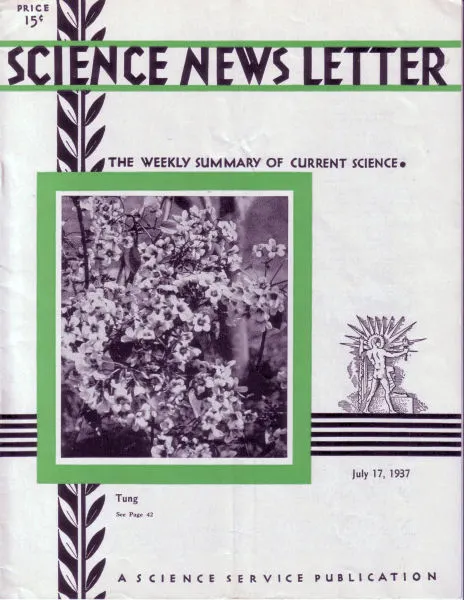From the July 17, 1937, issue

TUNG TREES IN AMERICA
Trees have taken marching orders from agriculture and industry for many ages. The trails of their migrations crisscross the map of the world. Every orchard you see is a regiment of trees that has marched into our land from somewhere afar; apples and pears from central Europe and interior Asia, cherries and peaches from Persia or China, all the citrus fruits from some rather vaguely determined region on the Road to Mandalay.
From our own New World, too, trees have gone a-marching: Para rubber from Brazil to Indonesia, quinine-yielding cinchona from the Andes to the uplands of the same British and Netherlands colonies, cacao from the Orinoco country to Africa. These beneficent invasions and counter-invasions by trees have been going on since the gray dawn of civilization, and they are going on still.
Newest recruits to these tree armies of agriculture and commerce are the Tung trees of China. Their forces are now in the neighborhood of the 4-million mark and increasing every year. They are entrenched all along the Gulf coast, from eastern Texas to northern Florida, across the peninsula as far south as Tampa Bay, and on to the sea on the southeastern coast of Georgia. A hundred miles wide is the territory considered suitable for Tung tree occupation along the Gulf, with a block at least three times that deep in northern and central peninsular Florida.
All this, where 5 years ago the total number of trees hardly reached the half-million mark.
OIL SHORTAGE MAY HIT U.S. DURING NEXT TWENTY YEARS
Unless new methods of obtaining and processing petroleum are developed, America may begin to feel the cramping hand of an oncoming oil shortage in from 10 to 20 years. This is the verdict of Dr. Arno C. Fieldner, chief of the technologic division of the U.S. Bureau of Mines.
Dr. Fieldner, speaking as president of the American Society for Testing Materials, outlined the present resources of the nation’s fuels in his address entitled, “Fuels of Today and Tomorrow.”
Of coal America has plenty, said Dr. Fieldner. Enough to last hundreds and perhaps a thousand or more years. But natural gas and oil obtained by present methods may be exhausted in less than a century, he warned.
Here is the significant forecast of Dr. Fieldner on America’s future fuels:
Coal will continue to be the chief fuel for the generation of public utility and major industrial power. While improved burning of coal might tend to decrease consumption and the further development of water power may be expected to increase, Dr. Fieldner sees an increasing demand for total energy needed by the country so that coal’s relative position should be favorable. Moreover, after 10 or 15 years, oil resources will become more difficult to exploit, so that the trend will favor the increased consumption of coal.
“Tomorrow’s power and central-heating plants will burn any kind of coal completely and efficiently,” said Dr. Fieldner. “There will be no smoke, no dust, and no sulfurous gases emitted to the atmosphere.”
NEW PRINCIPLE OF NATURE ABOUT TO BE DISCOVERED?
Either astronomers are soon to discover some new, hitherto unrecognized principle of nature or else telescopes like the 100-inch-diameter instrument of Mt. Wilson Observatory are now looking about to the limits of the universe.
This is the choice which Dr. Edwin Hubble, Mt. Wilson Observatory’s noted astronomer, extends to his fellow scientists. As soon as the new, 200-inch telescope being erected on Mt. Palomar, California, is in operation and studies on the light from the most distant nebulae are made with it, astronomy may have the answer to its present quandary.
The trouble is with the present theory of the expanding universe, which accounts nicely for the shifting of the light from distant nebulae toward the red end of the spectrum. The expanding-universe theory, one recalls, pictures some tremendous explosion in ages past which sent out matter that is still expanding. Just as the whistle of a train goes to a lower pitch as it rushes away from the observer so, too, in the optical case, does the light from a nebula rushing away from the observer go to a lower “pitch,” which, in the case of light, means a shift toward the red end of the spectrum. The trouble with this interpretation of the “red-shift” is that it leaves one with a universe that is small, closed, and dense; a universe whose outer limit is but little more than the present seeing limits of existing telescopes.







